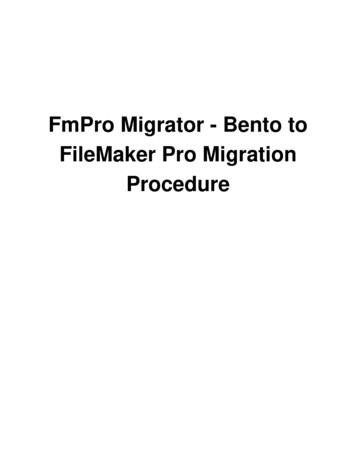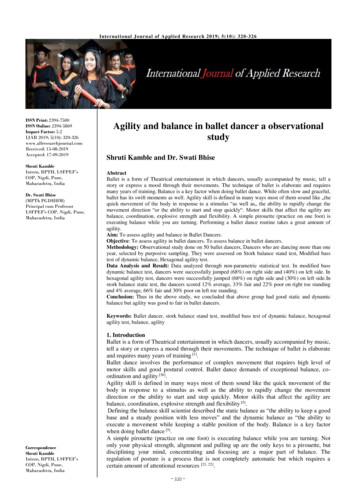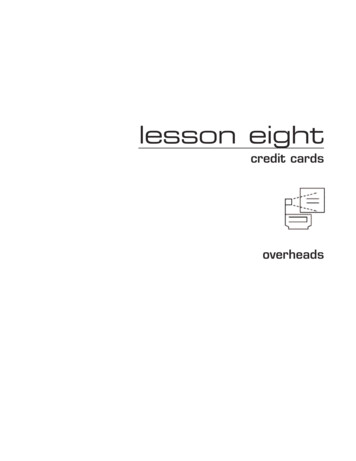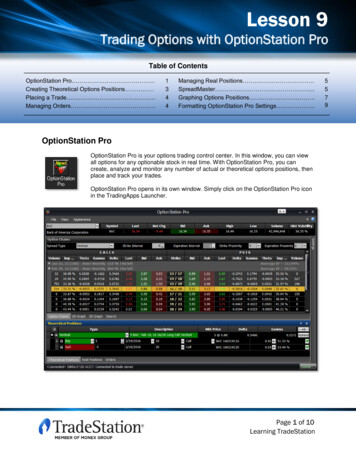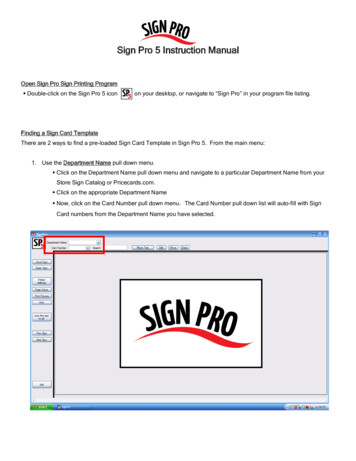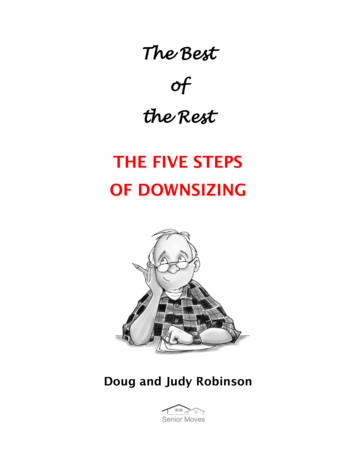
Transcription
Downsizing Your Debt
Credit cards are an important part of our financial lives. When usedwisely, they are a beneficial tool that helps us establish a positive credithistory. Despite all the advantages and conveniences credit cards canprovide, there are pitfalls associated with credit use. If a bill isn’t paid infull by the due date, finance charges will be added to what you owe, andif you make a late payment or exceed your credit limit, high penaltiesmay be added in as well. Over time, your balances will keep increasingand you may begin to feel overwhelmed, not knowing where to start.If you feel like you are in over your head, don’t worry - take action. Bydownsizing your debt you will take charge of your financial situation andbe in the position where you are in control of your money, rather thanyour money being in control of you.1
10 Warning Signs of Credit TroubleIf any of these potential warning signs of credit trouble sound familiar to you, it maybe time to change your financial habits:1. Paying only the minimum amount due on your credit cards2. Charging more each month than you make in payments3. Using credit and cash advances for items that used to be purchased with cash,like gas and groceries.4. Having a total credit balance that rarely decreases5. Being at or near your credit limit and applying for new cards6. Needing a consolidation loan to pay existing debt7. Not knowing the total amount that you owe8. Experiencing feelings of anxiety and stress whenever you use your credit cards9. Draining your savings to pay debts10. Making bill payments late2
Downsizing Your DebtPayoff strategies Stop buying on credit. In order to pay off your balances completely, you will have to stop charging on the cards. Think of credit cardsas plastic tools for taking out loans. Would you go to a bank and borrow 40 for dinner? If you use credit, track what you spend. Keep your non-mortgage credit payments to 20% or less of your take home pay. Call your credit card companies and see if they will lower your interest rates. Many will do so for their good customers when asked. Transfer your debt to one or two low-rate credit cards. If the card has a low introductory, or “teaser”, rate, make sure the interestrate you are charged once that expires is low too. Also, be careful to avoid charging up your old cards. If you do, you will only beincreasing your debt, not decreasing it. Increase your payments – if you stick to only the minimums, it could be years before you are debt free. To save the most money, sendextra cash to the cards with the highest interest rate first while maintaining at least the minimum payment on all other accounts. Or,if you want to see progress more quickly, focus on paying off the cards with the smallest balances. To see how long it will take you topay off your debt, use the financial calculations on our website at http://bit.ly/2KwG0BI. Use savings to pay off debt. It doesn’t make sense to pay 18% interest on a credit card to earn 3% on a savings account. Don’t,however, deplete your savings for periodic expenses. If your car breaks down, you don’t want to use your credit card to fix it. Send in your payment as soon as you receive the bill. Interest is usually calculated on an average daily balance, so every day you canreduce the balance, the more you will save in interest. Make more than one payment a month if possible. A consolidation loan is an option. However, low-rate loans can be difficult to get – particularly if you are carrying a large debt loador have credit problems. Beware of finance companies whose interest rates are higher than a credit card. The lower payment can betempting but it will cost you more in the long run. Pay more than the minimum scheduled payment (2%) of the remaining balance each month; it would take almost 30 years to pay offthe debt. Even if you made “power payments” of the initial 40 minimum payment each and every month, it would still take 8 yearsto pay off.Example: Total debt 2,0003MonthlypaymentInterestyou’ll payTotal you’ll payIf you pay the minimum (2%) 40 or less 4,943 6,943If you “power pay” 40 1,904 3,9048 yrs.If you pay 10 extra each month 50 1,113 3,1135 yrs.If you pay 50 extra each month 90 491 2,4912 yrs., 3 monthsIf you pay 100 extra each month 140 280 2,2801 yr., 4 monthsTime to pay off29 yrs.,11 months
Stretch Your DollarsFinding little places here and there that you can reduce expenses is key in freeing up money that you can use to pay down your debt.Remember, the more dollars that you can put towards paying down your debt each month, the more money you will save in interestcharges and time in paying off the debts. Below you will find some small ways that you can save big. Circle the items that you plan to putinto practice in the next 60 days.Saving on food costs1. Plan your meals one week at a time. Review grocery ads to take advantage of specials.2. Make a shopping list from your menu plan and the grocery ads. Post it on your refrigerator so you can keep a running list of what youneed. When you shop, buy only what’s on your list.3. Shop only once per week. You’ll spend less and have more free time.4. Grocery shop when you are not hungry – you’ll buy less.5. Use coupons for items you normally purchase if they are the best buy. Don’t buy something you don’t like just because you have acoupon for it.6. Buy generic or sale brands whenever possible. Look carefully, a name brand on sale could be more expensive than the generic brandat a regular price.7. Compare item price per unit—pound, ounce, dozen or package. Take your calculator with you! Buying a larger amount is usuallymore economical.8. Reduce purchases of snack and “junk” foods. Substitute fresh fruits and vegetables, juice drinks, and popcorn.9. Don’t buy convenience foods—make your own. Buy less expensive, more simple foods and drinks.10. Waste less! Plan the use of leftovers (planovers) and wrap and store items carefully.11. Double or triple recipes for spaghetti sauce, chili, and soups. Label and freeze for later use. This saves time and money.12. Entertain with pot-lucks or inexpensive buffets, serving meals such as spaghetti, lasagna and salad.13. Take your lunch to work and cut down on meals away from home.14. Buy produce at Farmer’s Markets. It’s fun, fresher and cheaper!Saving on transportation1. Have the scheduled maintenance done on your car. It is safer and cheaper in the long run.2. Learn how to do your own car maintenance. Take a class at a local Junior College if necessary. Change your oil and air filters asrecommended by your service manual.3. Use self-service gasoline pumps. Occasionally check oil and water levels.4. Form car pools to go to work, meetings and kid’s events.5. Cut down on short trips. As yourself, “Do I really need to make this trip?”6. Make lists of “things to do” and “things to buy” before you leave the house. Determine a route which uses your time and gas mostefficiently.7. Maintain and repair your existing car instead of buying a new one.8. Protect against salt, rust and scratches by waxing your car at least every three months.9. Increase deductibles on auto insurance to 500.10. Shop for the best value in car insurance. Check for multi-car and good student discounts.11. Consider dropping collision insurance when your car’s value has dropped significantly.12. Have kids use school and public transportation whenever possible.4
Saving around the home1. Learn how to refinish furniture. Get a book from the library orsecond-hand bookstores.2. Learn to clean and fix household items yourself.3. Reduce purchases of cleaning supplies. Buy products that havemultiple uses.4. Make small repairs to your home before they become big problems.5. Wash your walls instead of painting. Paint rather than re-plaster.6. Experiment with sponges, crumpled newspapers, rags, featherdusters to create your own painted “wallpaper.” Paint walls a basecolor in latex paint. Take 1 cup of base color, add a small amount ofanother color, dip one of the “daubers” in the new color, and touchthe wall in rows or in a random pattern.7. Clean out the attic and garage and have a yard sale. Get rid of stuff!8. Reduce use of air conditioning and open windows.9. Check the effectiveness of your insulation and improvewhere needed.10. Install an attic or roof fan.Save money on clothing1. Choose simple, basic styles that can be dressed up or dressed down depending on the occasion.2. Try to avoid fad or novelty styles that will be out of date next season. If you do buy these pieces, purchase at discount stores.3. Have your colors and personal style evaluated so you can buy clothing that works for you.4. Buy coordinated clothing that you can mix and match. Three tops and three bottoms can make nine outfits.5. Purchase new inexpensive accessories to jazz up an existing outfit.6. Check out discount stores, clearance centers and factory outlets. Don’t forget second-hand clothing stores.7. Plan your clothing purchases carefully, make a list of what you need, and then shop with those things in mind. Avoid impulse purchases.Now that you’ve been able to identify areas to reduce your expenses,you will have more money to aggressively pay down your debts!5
Debt Repayment PlanYou can use the following chart to create your plan for how you will pay off your accounts. This will help you to organize all of your debtsinto one place and clarify your payoff strategy in addition to setting goals for yourself. Use the extra money you found from StretchingYour Dollars to add to the minimum payments that you are making. As you follow through with your plan, you can acknowledge yourprogress by placing an “X” through an account once it is paid off. Each “X” you make gets you that much closer to becoming debt-free.CreditorAmount owedCurrent monthlypaymentInterest RateMonthly paymentgoalMonths to payoffTotal6
balancepro.org 888.456.2227 facebook.com/BALANCEFinFit twitter.com/BAL ProREV0419
downsizing your debt you will take charge of your financial situation and . track what you spend. Keep your non-mortgage credit payments to 20% or less of your take home pay. . Have your colors and personal style

